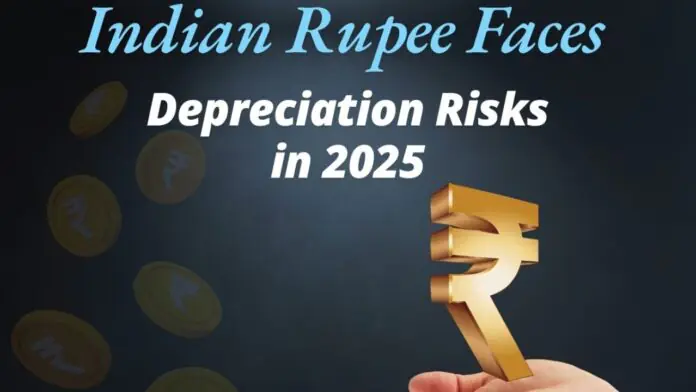Rupee Depreciation in 2025: The Indian rupee has been under significant pressure in recent months, hitting an all-time low of 85.78 against the U.S. dollar in December 2024. This marks a 3% depreciation over the year, driven by a combination of global and domestic factors. As India braces for further challenges in 2025, including a strong dollar, geopolitical tensions, and RBI interventions, the question arises: Is rupee depreciation inevitable, and can India manage exchange-rate volatility effectively?
Why Rupee Depreciation is Inevitable?
- Global Dollar Strength:
The U.S. dollar index (DXY) surged by 7% in 2024, closing the year at 108.4, and is expected to remain strong in 2025 due to the Federal Reserve’s hawkish stance and safe-haven demand amid geopolitical uncertainties. - Trade Deficit and Import Dependency:
India’s trade deficit widened to $31.46 billion in December 2024, driven by high imports of crude oil, gold, and industrial goods. The country imports 58% of its edible oil and 15-20% of its pulses, making these commodities vulnerable to rupee depreciation. - Foreign Capital Outflows:
Foreign institutional investors (FIIs) pulled out $4.5 billion from Indian markets in 2024, exacerbating the rupee’s decline. This trend is expected to continue in 2025 due to global economic uncertainties. - RBI’s Overvaluation Concerns:
The real effective exchange rate (REER) of the rupee stood at 108.14 in November 2024, indicating an 8% overvaluation. This makes Indian exports less competitive and highlights the need for gradual depreciation.
The Role of RBI in Managing Volatility
The Reserve Bank of India (RBI) has played a crucial role in stabilizing the rupee through strategic interventions. However, these efforts come at a cost:
- Forex Reserves Decline:
ndia’s forex reserves fell by $4.11 billion in December 2024, marking the twelfth decline in thirteen weeks. Reserves now stand at $640.28 billion, down from an all-time high of $704.89 billion in September 2024. - Intervention Strategy:
The RBI has sold $105 billion in forex markets since February 2022 to curb rupee volatility. While this has made the rupee one of the least volatile Asian currencies, it has also led to significant reserve depletion. - Cost of Overvaluation:
Holding large dollar reserves costs India $21 billion annually in foregone returns on non-dollar assets. However, RBI’s dollar sales have boosted dividend payouts to the government, providing fiscal relief.
Challenges and Policy Recommendations
- Export Competitiveness:
A weaker rupee can enhance export competitiveness, but overvaluation has hurt sectors like textiles, steel, and electronics. The RBI should allow gradual depreciation to support exports. - Dollar Dependency:
India’s reliance on dollar invoicing for 85% of its trade amplifies the rupee’s vulnerability. Promoting rupee invoicing with countries like Russia and Iran can reduce dollar dependency. - Attracting FDI:
To stabilize the rupee, India must attract foreign direct investment (FDI) by improving ease of doing business and focusing on sectors like IT, pharmaceuticals, and renewable energy. - Energy Independence:
Reducing dependence on imported crude oil, which accounts for 88.1% of India’s energy needs, can mitigate the impact of rupee depreciation on inflation and trade deficits 4.
Key Takeaways
- Rupee depreciation is inevitable due to global dollar strength, trade deficits, and capital outflows.
- The RBI’s interventions have stabilized the rupee but at the cost of forex reserves and export competitiveness.
- Gradual depreciation, reduced dollar dependency, and FDI inflows are key to managing volatility.
- India must focus on energy independence and export-driven growth to build economic resilience.
Conclusion
The rupee’s depreciation in 2025 is a reflection of global economic forces, but its volatility can be managed through prudent policymaking. By allowing gradual depreciation, reducing dollar dependency, and attracting stable capital flows, India can navigate the challenges of a strong dollar and build a more resilient economy.
For more insights on the rupee’s trajectory and its impact on the economy, stay tuned to expert analyses and official announcements.


